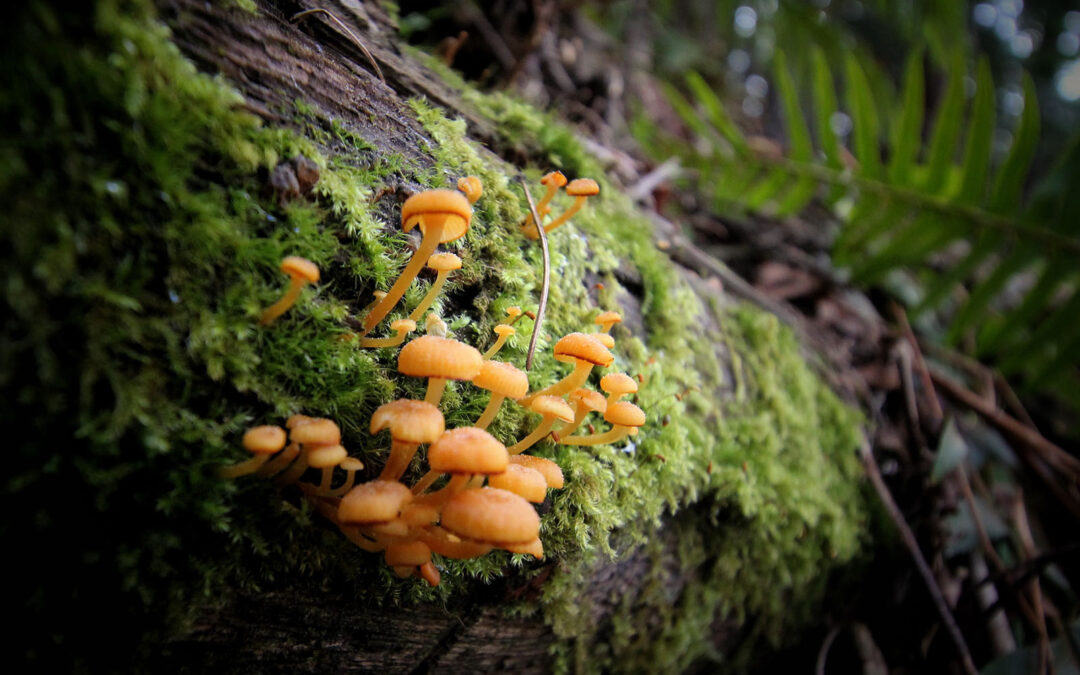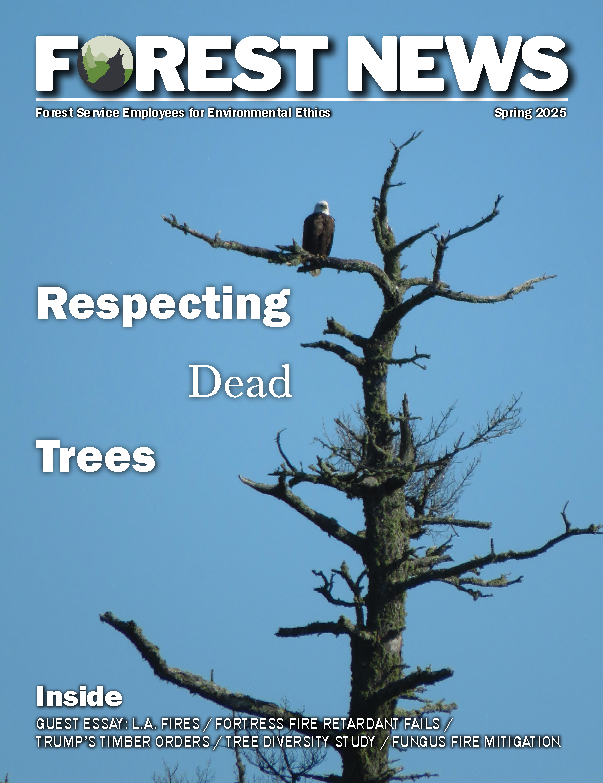Dead trees have become a frequent target of the Forest Service in the years since the agency was forced to stop allowing clear-cut logging of old-growth trees. Either labeled as “hazard trees” or subject to “salvage logging,” dead trees have been identified by the Forest Service as easy targets. As an agency in the Department of Agriculture, the Forest Service has never been overly fond of dead trees — unless they died at the hands of timber companies as a crop harvested to support private-sector profits. But now, after being forced to restrict old-growth logging, the Forest Service has labeled dead trees, especially those killed by native insects and endemic fire, as bad, thereby justifying their extraction to support an unsustainable socio-industrial economic model.
Among the clear-sighted individuals standing up for dead trees is ecologist George Wuerthner: “Like most people I once viewed dead trees as an indicator of some presumed problem in the forest — that a ‘healthy’ forest was one with a minimum of dead trees and largely free of wildfire, insects, and disease…. I now understand that large numbers of dead trees are critical to functioning forest ecosystems. There is no disputing the ecological importance of dead trees. Dead trees and down wood play an important role in ecosystems by providing wildlife habitat, cycling nutrients, aiding plant regeneration, decreasing erosion, and influencing drainage and soil moisture and carbon storage.”
Scientific findings about the ecological importance of dead wood have been largely ignored by the Forest Service since at least the Obama administration. In 2015, the Forest Service reported spending more than half of its total discretionary budget on firefighting activities, including “hazardous fuels reduction,” which encompasses salvage logging of dead trees. By 2016, aerial surveys showed an increase in the number of dead, drought-stricken trees in California. President Barack Obama’s Secretary of Agriculture, Tom Vilsack, pushed for allocating more than 65% of the entire Forest Service budget to firefighting and fire-mitigation activities. The increasing number of dead trees, he said, “clearly increases the risk of what we’re already experiencing, a record-setting fire season in California.”
Vilsack’s comments represent a paradigm that continued to be advanced through the first Trump administration and the Biden administration, in which Vilsack again served as Ag secretary. That paradigm also provides the rationale for current Secretary of Agriculture Brooke Rollins’ recent Secretarial Memorandum proclaiming an emergency situation on almost 80 million acres of national forest lands because they are “at risk of experiencing substantially increased tree mortality … from insect and disease infestation; or containing hazard trees” — i.e., dead or dying trees that supposedly pose “an imminent risk to public health, infrastructure, and safety.”
According to this paradigm, fires and insects are bad — i.e., natural processes are destroying our forests by killing trees. So, the Forest Service spends billions of dollars each year in an effort to contain wildfire and insect outbreaks because stand-replacing wildfires and large outbreaks of native insects are viewed as something that needs to be suppressed or controlled. For perspective, currently perceived increases in fire and insect harm are directly linked to relatively short-term human interventions as well as long-term natural processes.
Regardless of the scientifically shallow, subjective roots of this paradigm, a growing body of research topples the oft-repeated ideas that (1) dead trees aplenty are bad and (2) wildfires and insects are destroying our forests. Since wildfire and insect outbreaks have persisted in our forests for millenia, the current extent of these “problems” is not unprecedented if we look back beyond 100 years, which is analagous to other natural events like hundred-year floods/blizzards/droughts/etc. These “extreme” events have always played a role in shaping our ecosystems and ensuring their resilience.
In a 2004 article in Conservation Biology, Richard Hutto, ecology professor and former director of the Avian Science Center at the University of Montana, wrote, “Everything from the system of fire-regime classification, to a preoccupation with the destructive aspects of fire, to the mis-application of snag-management guidelines have led us to ignore the obvious: we need to retain the very elements that give rise to much of the biological uniqueness of a burned forest — the standing dead trees.”
The list of beneficial functions of dead trees is extensive. Supporting wildlife is one of the few that gets any recognition. Hutto reports that at least 60% of species that nest in severely burned forests use only snags for nest sites, and as many as 45% of North American bird species rely on snags at some point in their life cycle. Hutto’s research shows that 15 of those species are most abundant in forests with high snag numbers resulting from high-intensity stand-replacing fires. That these bird species evolved to rely on snags provides strong evidence that stand-replacing fires and large insect outbreaks were neither uncommon nor unnatural, as the Ag Department paradigm would have us believe.
Birds are just one example of ecosystem reliance on dead trees. Burned forests also provide important food sources for wildlife attracted by seeds released from fire-activated cones and new groundcover plants. Cold-blooded species like salamanders rely on dead trees. Ants, pollinators and lichens play significant roles in forest ecosystems and also rely on dead trees. Healthy soil structure with adequate organic matter requires dead trees. Dead trees help create healthy aquatic ecosystems in streams.
And yes, even bark beetles contribute to ecosystem health. By breaching the outer layer of tree bark, they create pathways for fungus and other insects to get inside trees and speed up the decomposition process. The pheromones they release to attract other beetles also attract insects that prey on bark beetles. Plus, the compounds released from the decomposing trees attract other organisms that feed on dead wood. Research also shows bark beetle outbreaks increase biodiversity in forest ecosystems.
Any reasonably objective analysis of salvage logging, “hazard tree mitigation,” and their effects on forest health reveals the significant ecological costs of these logging practices. In a 2006 paper, Hutto wrote, “I am hard-pressed to find any other example in wildlife biology where the effect of a particular land-use activity is as close to 100% negative as the typical post-fire salvage-logging operation tends to be.” While Hutto’s findings focus on post-fire logging, many of his conclusions apply to any forest management practice that significantly reduces the amount of dead wood in the forest.
As Wuerthner concludes, “Planning to maintain current and recruit future dead wood in the forest will go a long way toward promoting overall forest health, resilience, biodiversity, and wildlife habitat.”
Photo: Mushrooms, moss, and ferns flourish on the remnants of a tree in Idaho Panhandle National Forest (Forest Service photo by Elisha Stamm).


